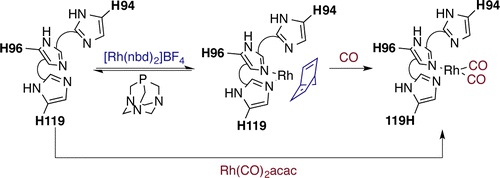Generation, Characterization, and Tunable Reactivity of Organometallic Fragments Bound to a Protein Ligand
J. Am. Chem. Soc., 2015, 137 (8261-8268)
View on publisher site
Abstract
Organotransition metal complexes catalyze important synthetic transformations, and the development of these systems has rested on the detailed understanding of the structures and elementary reactions of discrete organometallic complexes bound to organic ligands. One strategy for the creation of new organometallic systems is to exploit the intricate and highly structured ligands found in natural metalloproteins. We report the preparation and characterization of discrete rhodium and iridium fragments bound site-specifically in a κ2–fashion to the protein carbonic anhydrase as a ligand. The reactions of apo human carbonic anhydrase with [Rh(nbd)2]BF4 or [M(CO)2(acac)] (M=Rh, Ir) form proteins containing Rh or Ir with organometallic ligands. A colorimetric assay was developed to quantify rapidly the metal occupancy at the native metal-binding site, and 15N-1H NMR spectroscopy was used to establish the amino acids to which the metal is bound. IR spectroscopy and EXAFS revealed the presence and number of carbonyl ligands and the number total ligands, while UV-vis spectroscopy provided a signature to readily identify species that had been fully characterized. Exploiting these methods, we observed fundamental stoichiometric reactions of the artificial organometallic site of this protein, including reactions that simultaneously form and cleave metal-carbon bonds. The preparation and reactivity of these artificial organometallic proteins demonstrate the potential to study a new genre of organometallic complexes for which the rates and outcomes of organometallic reactions can be controlled by genetic manipulation of the protein scaffold.
Read on publisher's site